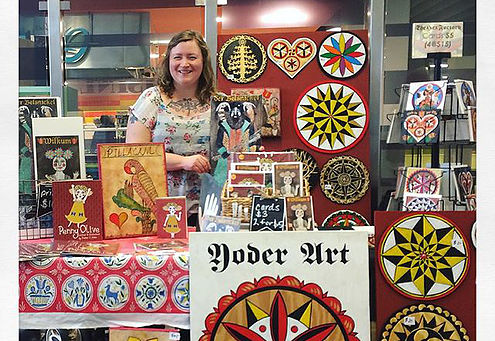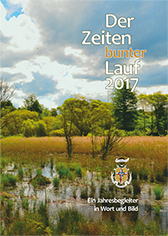Rachel Yoder und "Der Zeiten bunter Lauf 2017"
Ein Jahresbegleiter in Wort und Bild
Buchcover des neuen Kalenderbuches für 2017
Gemäß historisch überlieferten Veröffentlichungsformen der Region hat sich der Verein für kulturelle & geschichtliche Atbeit im Bisttal dazu entschlossen, den Kalender in Buchform wieder aufleben zu lassen. Er enthält neben einem Kalendarium für 2017 zahlreiche Texte und Beiträge zu unterschiedlichen Theman und Gebieten, wie dies in historischen Kalenderbüchern seit dem 17. Jahrhundert üblich gewesen ist. Dazu gehören auch Beoträge, die sich mit unserem regionalen Brauchtum und den Mundarten beschäftigen. Die im Saarraum verbreiteten Rhein- und Moselfränkischen Mundarten werden in mundartlichen Texten ebenfalls thematisiert.
Es hat uns besonders gefreut, die in Pennsylvanien lebende Künstlerin Rachel Yoder mit einem Interview und der Erlaubnis, einer ihrer Bilder im Kalender abdrucken zu dürfen zur Mitarbeit für diesen Kalender zu gewinnen. Rachel Yoer - selbst aus einer deutschstämmigen Famile stammend - beschäftigt sich in ihrer Kunst intensiv mit den überlieferten Bild- und Erzähltraditionen der deutschsprachigen Einwanderer in Pennsyvanien. Figuren wie beispielsweise der 'Beltznickel', die wir im südpfälzischen Raum, aber auch im Bitscher Land in der worweihnachtlichen Tradition noch vorfinden, hat Rachel Yoder vielfach gemalt und in Kunstwerken verarbeitet. In Begleitung einiger Informationen zu Ihrem künstlerischen Schaffen, aber auch dem Beitrag mit Bezug auf Rachel Yoder im aktuellen Kalenderbuch haben wir ihr ein paar Fragen gestellt, die sich mit ihrer Kunst und Kultur befassen, aber auch mit der Bedeutung der Überlieferung der Kultur der Auswanderer in Amerika. Nachfolgend das Interview mit Rachel Yoder im vollen Wortlaut in englischer Sprache:

Hallo Rachel since when are you focussing your interest on the art and culture of the old Pennsylvanian inhabitants, mostly with German backgrounds?
I have been an artist my whole life (35 years), but it wasn't until 2011 that I created work with ancestral significance. I was introduced to PA Deitsch art by learning to paint hex signs. The process was transformative!! I was entranced from the first sweep of the compass of my first hex sign. To me, creating art that was deeply rooted in my ancestral heritage took my art work to a new level of authenticity, voice and style. I am a gestural drawer/painter, I love to portray people. Fraktur style drawing hooked me as soon as I started researching it because it is so free from structure and full of life and motion in each stroke. Around the same time I travelled to the Pennsylvania German Cultural Heritage Center at Kutztown University to attend Christmas on the Farm. There I met der Belsnickel for the first time. I was enamored! I felt so drawn to his dark and tattered appearance, I envisioned a grungy folk art painting on old barn wood for my new friend. When I got home I painted him and the rest is history!
How is your personal family rooted in this?
My family was more craftspeople. My mother, grandmother and great-grandmother all sewed and embroidered primarily. They also crocheted and Mom did Scherenschnitte. All of their talents influenced me and my own craft as a child and young person. Geographically, our family has been in the Oley Valley since the early 1700's, so our Pennsylvania Deitsch roots are deep and strong. My mentor is the person that introduced me to the art of hex signs and fraktur paintings.
Whats makes you fun in this kind of art?
I'm sexy! Ha ha ha! No really, I am a modern woman doing a very traditional style of artwork but through my contemporary perspective. I love to incorporate the figure as much as I can. You will see Wassernix, or mermaids in my work bare-chested and unapologetic. I worship the gods and goddesses in us all. My figures are like PA Deitsch deities to me.
How do you believe, that your art is a prolongation of passed on tradition?
My artwork has hopefully excited and encouraged people to look at the fantastic fraktur work of our ancestors. They made these incredibly and wildly strange illustrations for their Taufschein and other certificates. These illustrations are often viewed as secondary to the gorgeous penmanship, but I felt my spirit ignited by them! They sang to me and begged me to recreate them larger and bolder! I am not a traditional folk artist in that I don't simply reproduce the artwork, I reimagine it and reframe it within my context and experience.
Do you believe, that in our modern times, the preservation of traditions is important?
As I have gotten older and grown my own family I have felt more and more strongly that tradition and pride is extremely important most especially for young people. This is why I wrote Penny Olive. It is invaluable for young people to know who they are and where they came from, but most importantly that they belong. This is my mission for my children and other PA Deitsch children. I am also a trained art teacher and I just love to see both boys and girls, learning ALL of the crafts and arts of our people. Not just the crafts that have been traditionally just for either men or women. My goal is to promote Pennsylvania Deitsch folk art in this way, equally, and that is what is most reflective of the 21st century in my art. I have written and illustrated a children's book to do just that. Penny Olive takes young people on adventures throughout Berks County and Pennsylvania Deitsch folk traditions, but she is a very modern girl. It's exciting to be finally braiding together all of my passions: art, cultural preservation and education!
Do you intend as well the possibility of cultural exchange with your art?
I'm not sure I know exactly to what you are referring, but perhaps to the exchange between PA Deitsch in Pennsylvania and Germans in the Palatines, yes absolutely! I have become very close with Dr. Micheal Werner in Germany and he is the publisher of Hiwwe wie Driwwe (over here as over there). We are made of the same fabric just on different quilts.
Should one focus more the knowledge of the German dialects brought into the US by the German immigrants from the 17th century till today?
What a fantastic question! I always say to people that that is the most urgent cause amount us is to preserve the PA Deitsch language that is unfortunately dying off with the last generation of people for whom it was their first language. My grandmother being one of them. She was forced to stop speaking the dialect in grad school during WWI anti-German hysteria. Many people I meet have similar narratives. She was also badly mocked in college for her dumb Dutchmen accent and put in a speech clinic. It is so sad. These negative experiences caused many PA Deitsch speakers to not want to pass the language on to their children and in turn make them targets for this type of ridicule. So many of our families have a generational gap that didn’t learn the language.
There are however many contemporary efforts to teach the language and help preserve it. Douglas Madenford, a friends and wunnerbaar guy has a series of YouTube tutorial and a work book Schwetz mol Deitsch. Also Keith Brintzenhof teaches a class at Kutztown University and many community centers in the area. I took Keith’s class and I loved it! But it’s tough. Learning a language as an adult is not too easy. But it’s worth the effort and preservation. In the past year I have been slowly getting better and better.
Gross Danke Patrik for your interest in my work and I look forward to more collaboration in the future! Mach’s gut!
![]()
Informationen und eine gute Auswahl mit zahreichen Bildern und Texten zu Rachel Yoder findet sich unter http://www.rachelyoderart.net, wo sich auch unser oben wiedergegebenes Interview befindet. Wir planen das äußerst interessante Interview in die deutsche Sprache zu übertragen
